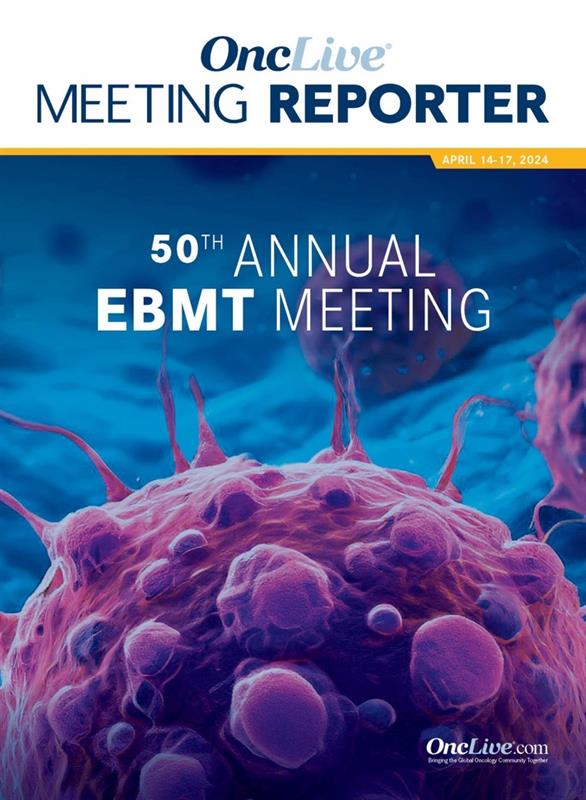News
Article
Orca-T Proves Safe and Effective in Advanced Hematologic Malignancies
Author(s):
The regulatory T cell enriched donor cell agent Orca-T was safe and displayed activity in the reduced intensity conditioning setting for patients with advanced hematologic malignancies.
Alejandro Villar-Prados, MD, PhD

The regulatory T cell enriched donor cell therapy Orca-T proved to be a safe and feasible alternative to conventional transplant for patients with advanced hematologic malignancies in the reduced intensity conditioning setting, according to findings from a phase 1 study (NCT05088356) presented during the 50th Annual EBMT Meeting.1
At the December 1, 2023, data cutoff, at a median follow-up of 9.65 months (range, 1.0-22.6), interim results from the study demonstrated that patients who received Orca-T cell therapy in combination with reduced intensity conditioning and tacrolimus (n = 20) achieved a 12-month relapse-free survival rate of 77% (95% CI, 49%-91%); notably no surviving patients experienced disease relapse and 4 patients died. Four patients developed acute or late acute onset grade II to IV graft-versus-host disease (GVHD), no patients developed acute or late acute onset grade III to IV GVHD, and 1 patient developed moderate to severe chronic GVHD.
“Reduced intensity conditioning allogenic bone marrow transplant remains the only curative option for older/unfit patients with hematological malignancies,” Alejandro Villar-Prados, MD, PhD, a hematology and oncology fellow at Stanford University School of Medicine in Palo Alto, California, and coauthors wrote in a poster presentation of the trial. “Orca-T cell therapy is a viable approach in the reduced intensity conditioning setting for patients with hematological malignancies, with robust engraftment and no new safety signals identified.”
The single-center, open-label feasibility and safety study enrolled patients who were 18 to 75 years old with histopathologically-confirmed acute myeloid, lymphoid, or mixed phenotype leukemia in complete remission (CR) or CR with incomplete hematologic recovery (CRi) or beyond first complete remission without the presence of minimal residual disease (MRD). Patients could not have disease in morphologic CR with bone marrow infiltration by leukemic blasts of 10% or less, or in morphologic CR with evidence of MRD positivity. Patients with primary refractory acute myeloid, lymphoid, or mixed phenotype leukemia, chronic myelogenous leukemia, myelodysplastic syndromes, or myeloproliferative syndromes were also eligible.2
The study was divided into arms A1 (n = 11), A2 (n = 7), and C (n = 2). All patients received fludarabine 40 mg/m2 on days -7 to -4, total body irradiation of 2 Gy on days -3 to-2, andtacrolimus 5 to 10 ng/mL following day 3. Patients in arm A1 also received melphalan 50 mg/m2 on day -7, patients in arm A2 received thiotepa 10 mg/kg on day -7 to -6, and patients in arm C received thiotepa 10mg/kg on day -7 to -6 as well as mycophenolate 1000 mg after day 4. On day 0, all patients were treated with a hematopoietic stem and progenitor cell infusion of 1.5 to 5.8 x 106 cells/kg and Treg infusion of 2 to 3 x 106 cells/kg followed by Tcon infusion of 2 to 3 x 106 cells/kg after day 2.1
The coprimary end points were GVHD-free RFS following hematopoietic cell transplantation, overall survival (OS) post-HCT, incidence of grade III to IV acute GVHD, incidence and timing of primary graft failure, and donor CD3 chimerism at day 60-plus post-HCT. Secondary end points included OS, GVHD-free RFS, secondary graft failure, treatment-emergent adverse effects, any-grade acute GVHD, and disease-free survival, among others.2
At baseline, the median age in the overall population was 68 years (range, 65-72) and the median Karnofsky performance score was 90% (range, 70%-100%). Most patients were male (70%) and the medianhematopoietic cell transplantation comorbidity index was 3.0 (range, 0-5). The study included patients with acute myelogenous (n = 11), acute lymphoblastic (n = 2), and mixed phenotype acute (n = 1) leukemias, as well as patients with myeloproliferative neoplasms (n = 3) and myelodysplastic syndrome (n = 3). All patients with acute leukemia were in CR or CRi.1
Additional findings from the trial revealed that the median CD15 donor chimerism was 100% (range, 99%-100%) at day 30 and 100% (range, 98%-100%) at day 90. The median CD3 chimerism was 98% (range, 40%-100%) and 99% (range, 78%-100%), respectively. The median day of neutrophil and platelet engraftment was 14.5 (range, 9-35) and 19 (range, 14-70), respectively; 2 patients required a CD34-plus boost as well.
Further, safety data showed that 6 patients developed grade 3 or higher infections in the first 90 days following transplant, including bacteremia (n = 3), viremia (n = 1), and fungal pneumonia (n = 2). Two patients died from severe infections and there were also 2 cases of hepatic sinusoidal obstruction.
References
- Villar-Prados A, Sutherland K, Negrin R, et al. Phase I trial results for patients with advanced hematological malignancies treated with ORCA-T cell therapy with reduced intensity conditioning and single agent tacrolimus. Presented at: EBMT 50th Annual Meeting; April 14-17, 2024. Abstract A121.
- Reduced intensity allogeneic HCT in advanced hematologic malignancies w/T-Cell depleted graft. ClinicalTrials.gov. Updated February 20, 2024. Accessed April 15, 2024. https://clinicaltrials.gov/study/NCT05088356









